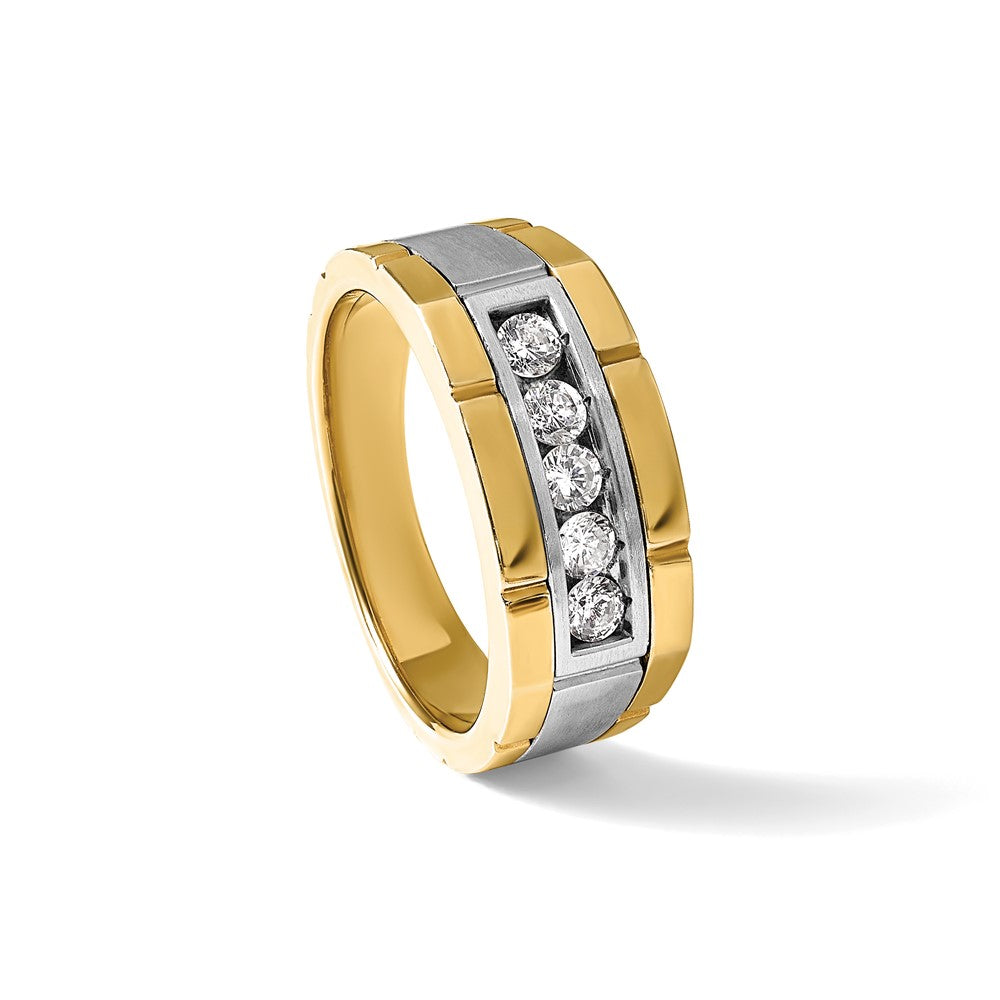
Free Domestic & International Shipping for All Orders Over $250 Shop Now








The IBGoodman 14k Two-Tone Men's Ring is a stunning statement piece for the modern man. Crafted in luxurious 14k gold, this band showcases a mix of polished and satin finishes, adding to its refined elegance. Five lab-grown diamonds, totaling a 1/2 carat, sparkle brilliantly against the ring's two-tone design. These diamonds boast a clarity rating of VS/SI+ and a striking G+ color grade, ensuring exceptional shine. Each stone is expertly faceted and precision-cut to a perfect round shape. This IBGoodman ring delivers a bold aesthetic with its 9.82 mm width, perfect for those who appreciate sophistication.
SKU: B63919-4YWLG
UPC: 196904328491
Precious Metal Type: 14k Two-tone
Width: 9.82 mm
Weight: 7.51 gm
Diamond Weight: 0.515 gm
What Are Lab-Created Diamonds?
Lab-created diamonds are an exceptional blend of science and craftsmanship. While natural diamonds are formed deep within the earth over billions of years, lab-created diamonds are grown in controlled environments using advanced technology that replicates the natural process. By applying extreme heat and pressure, these diamonds are fully formed within weeks to months. Since they can be produced in abundance, lab-created diamonds are typically more affordable, making larger diamonds more accessible. However, their abundance may affect their long-term value.
Are lab-created diamonds the same as natural diamonds?
Lab-created diamonds share the same optical, physical, and chemical properties as natural diamonds. The primary difference lies in their origin and the time taken to form.
Is a lab-created diamond better?
Both lab-created and natural diamonds vary in grading. Lab-created diamonds often allow buyers to maximize their budget, offering more size for the same cost. Natural diamonds, however, are celebrated as unique works of nature.
Where do lab-created diamonds come from?
Lab-created diamonds are formed in laboratories using advanced technology. A diamond seed—a tiny carbon crystal—is exposed to high heat and pressure with a carbon coating to grow into a larger diamond crystal.
Are lab-created diamonds or natural diamonds higher quality?
Neither type is inherently higher quality, as both are available in a range of colors, cuts, clarity, and carat weights.
Can a trained eye distinguish lab-created from natural diamonds?
Because lab-created diamonds share the same optical, chemical, and physical characteristics as natural diamonds, they cannot be distinguished even under 10x magnification.
Finish: Polished
Stone Quantity_1: 5
Band Width: 9.82 mm
Feature: Solid
Stone Shape_1: Round
Stone Size_1: 3 mm
What Are Lab-Created Diamonds?
Lab-created diamonds are an exceptional blend of science and craftsmanship. While natural diamonds are formed deep within the earth over billions of years, lab-created diamonds are grown in controlled environments using advanced technology that replicates the natural process. By applying extreme heat and pressure, these diamonds are fully formed within weeks to months. Since they can be produced in abundance, lab-created diamonds are typically more affordable, making larger diamonds more accessible. However, their abundance may affect their long-term value.
Are lab-created diamonds the same as natural diamonds?
Lab-created diamonds share the same optical, physical, and chemical properties as natural diamonds. The primary difference lies in their origin and the time taken to form.
Is a lab-created diamond better?
Both lab-created and natural diamonds vary in grading. Lab-created diamonds often allow buyers to maximize their budget, offering more size for the same cost. Natural diamonds, however, are celebrated as unique works of nature.
Where do lab-created diamonds come from?
Lab-created diamonds are formed in laboratories using advanced technology. A diamond seed—a tiny carbon crystal—is exposed to high heat and pressure with a carbon coating to grow into a larger diamond crystal.
Are lab-created diamonds or natural diamonds higher quality?
Neither type is inherently higher quality, as both are available in a range of colors, cuts, clarity, and carat weights.
Can a trained eye distinguish lab-created from natural diamonds?
Because lab-created diamonds share the same optical, chemical, and physical characteristics as natural diamonds, they cannot be distinguished even under 10x magnification.